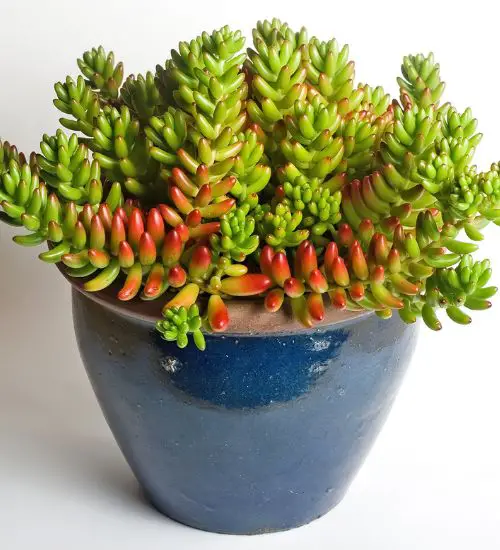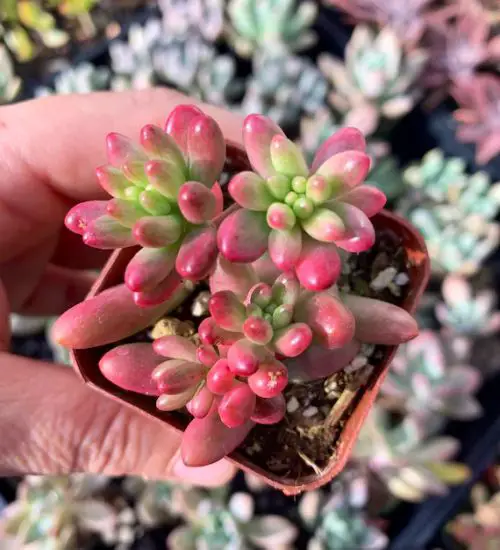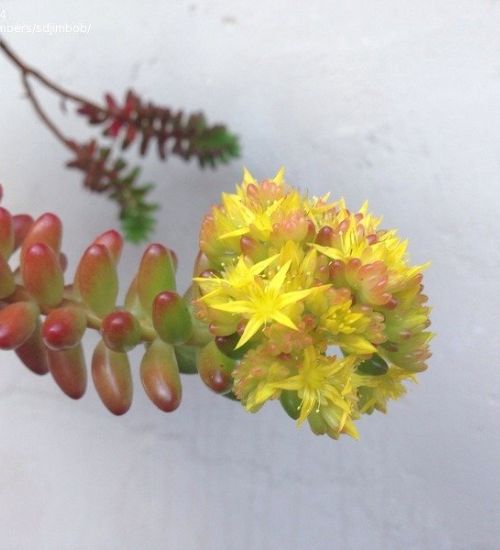Sun: full sun
Water: Typical water needs for a succulent
Temperature: Zone 9a from 20° F to 25° F (-6.7 ° C to -3.9° C)
Winter Survival: Not cold hardy
Propagation: leaves, stem cuttings
Flower: In the Spring
Flower Type:
Toxic: Can be toxic to humans and animals
Dormant: summer
Space Requirement: Indoors & Outdoors
Common Problems: Plants may rot if overwatered, pests
Where to buy Sedum rubrotinctum?
Basc Care for Sedum rubrotinctum
Watering
Can you water your succulent more than what its need? The answer is yes and no. In extreme conditions, you can water your plants more often when you notice the soil is completely dry.
One simple tip for you is that you can use some online apps to check the soil status before you go water your succulents. I would recommend the ThePlantsCheck app, it has some nice features there.
Fertilizing
Only feed this succulent during its active growing seasons which means winter. Use the right fertilizer applied in the right amounts. Applying half-strength balanced fertilizer every month or so is recommended for optimal results.
Do not fertilize during summer as the plant is dormant.
Sun & Location Requirements for "Pork and Beans, Jelly Beans"
To ensure Sedum rubrotinctum grows to its fullest potential, make sure it receives plenty of direct sunlight. Aim for six hours or more of full sun a day – the ideal place would be near a sunny window or outdoors in your garden. Monitor the leaves closely; if they become pale or soft, relocate the plant to a sunnier spot.
As per this succulent profile, it is only able to stay healthy when the environment temperature is above the range of zone 9a from 20° F to 25° F (-6.7 ° C to -3.9° C).
When temperatures drop below freezing, it is important to take precautions to protect Sedum rubrotinctum from the cold. Insulating and providing adequate drainage for the plant are key elements in helping it survive winter weather. Wind and sun exposure should also be minimized to prevent frost damage.
Any succulents in the group will need a medium space to grow. You can place your pot at your table or window. Since this plant needs more space than mini succulents, you should consider do not plant them together with other succulents/plants.
Propagation
Propagating succulents from leaves is an easy and cost-effective way to grow new plants. All you need are a few healthy leaves from the mother plant, some potting mix, and regular watering. After a few weeks you'll have brand new succulents that you can watch grow!
Successfully propagating succulents is a great way to increase your collection of these unique houseplants. To propagate Sedum rubrotinctum by stem cuttings, you’ll need a few supplies including a sharp, clean knife and soil.
Toxicity

The toxicity of Sedum can vary depending on the individual species, but all species are potentially dangerous if ingested. Symptoms of poisoning may include vomiting, abdominal pain, diarrhea and dizziness. If you believe someone has ingested parts of Sedum rubrotinctum, seek medical help immediately.
Pests and Diseases
Sedum rubrotinctum can be affected common pests and diseases like most of the other succulents such as snails, grasshoppers, and caterpillars.
If you do spot any of pest signs, you can treat your succulent using below methods.
- Snails: clean infected plants, soapy water.
- Grasshoppers: Treat with insecticides or Sprinkle flour on the leaves of your plants..
- Caterpillars: squish them, clean your infected plants.
Besides that, to prevent serious health issues from happening, keep your succulent in a well-ventilated area and check it regularly for any signs of pests or health problems.


